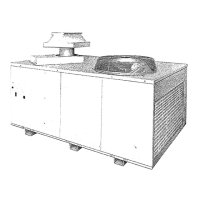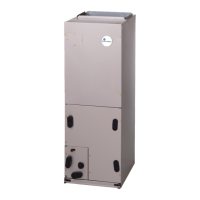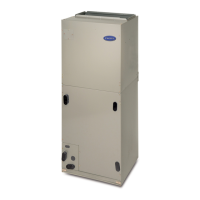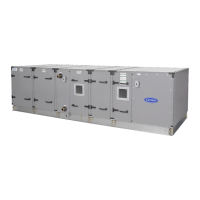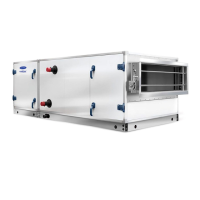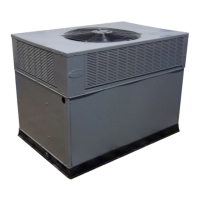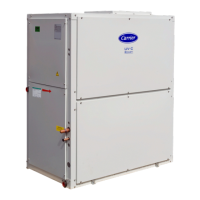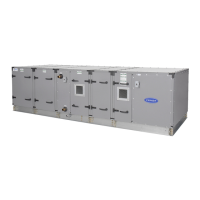51
the CO
2
sensor output will be 6.7 volts. Line up the point on
the graph with the left side of the chart to determine that the
range configuration for the CO
2
sensor should be 1800 ppm.
The EconoMi$er IV controller will output the 6.7 volts from
the CO
2
sensor to the actuator when the CO
2
concentration in
the space is at 1100 ppm. The DCV set point may be left at
2 volts since the CO
2
sensor voltage will be ignored by the
EconoMi$er IV controller until it rises above the 3.6 volt set-
ting of the minimum position potentiometer.
Once the fully occupied damper position has been determined,
set the maximum damper demand controlled ventilation poten-
tiometer to this position. Do not set to the maximum position
as this can result in over-ventilation to the space and potential
high humidity levels.
CO
2
Sensor Configuration
The CO
2
sensor has preset standard voltage settings that can be
selected anytime after the sensor is powered up.
Use setting 1 or 2 for Carrier equipment
1. Press Clear and Mode buttons. Hold at least 5 seconds until
the sensor enters the Edit mode.
2. Press Mode twice. The STDSET Menu will appear.
3. Use the Up/Down button to select the preset number.
4. Press Enter to lock in the selection.
5. Press Mode to exit and resume normal operation.
The custom settings of the CO
2
sensor can be changed anytime
after the sensor is energized. Follow the steps below to change
the non-standard settings:
1. Press Clear and Mode buttons. Hold at least 5 seconds
until the sensor enters the Edit mode.
2. Press Mode twice. The STDSET Menu will appear.
3. Use the Up/Down button to toggle to the NONSTD menu
and press Enter.
4. Use the Up/Down button to toggle through each of the nine
variables, starting with Altitude, until the desired setting is
reached.
5. Press Mode to move through the variables.
6. Press Enter to lock in the selection, then press Mode to
continue to the next variable.
Dehumidification of Fresh Air with DCV (Demand Controlled
Ventilation) Control
If normal rooftop heating and cooling operation is not adequate
for the outdoor humidity level, an energy recovery unit and/or
a dehumidification option should be considered.
ECONOMI$ER IV PREPARATION
This procedure is used to prepare the EconoMi$er IV for trou-
bleshooting. No troubleshooting or testing is done by perform-
ing the following procedure.
NOTE: This procedure requires a 9-v battery, 1.2 kilo-ohm re-
sistor, and a 5.6 kilo-ohm resistor which are not supplied with
the EconoMi$er IV.
1. Disconnect power at TR and TR1. All LEDs should be off.
Exhaust fan contacts should be open.
2. Disconnect device at P and P1.
3. Jumper P to P1.
4. Disconnect wires at T and T1. Place 5.6 kilo-ohm resistor
across T and T1.
5. Jumper TR to 1.
6. Jumper TR to N.
7. If connected, remove sensor from terminals SO and +.
Connect 1.2 kilo-ohm 4074EJM checkout resistor across
terminals SO and +.
8. Put 620-ohm resistor across terminals SR and +.
9. Set minimum position, DCV set point, and exhaust poten-
tiometers fully CCW (counterclockwise).
10. Set DCV maximum position potentiometer fully CW
(clockwise).
11. Set enthalpy potentiometer to D.
12. Apply power (24 vac) to terminals TR and TR1.
DIFFERENTIAL ENTHALPY
To check differential enthalpy:
1. Make sure EconoMi$er
®
IV preparation procedure has
been performed.
2. Place 620-ohm resistor across SO and +.
3. Place 1.2 kilo-ohm resistor across SR and +. The Free
Cool LED should be lit.
4. Remove 620-ohm resistor across SO and +. The Free Cool
LED should turn off.
5. Return EconoMi$er IV settings and wiring to normal after
completing troubleshooting.
SINGLE ENTHALPY
To check single enthalpy:
1. Make sure EconoMi$er IV preparation procedure has been
performed.
2. Set the enthalpy potentiometer to A (fully CCW). The
Free Cool LED should be lit.
3. Set the enthalpy potentiometer to D (fully CW). The Free
Cool LED should turn off.
4. Return EconoMi$er IV settings and wiring to normal after
completing troubleshooting.
DCV (DEMAND CONTROLLED VENTILATION) AND
POWER EXHAUST
To check DCV and Power Exhaust:
1. Make sure EconoMi$er IV preparation procedure has been
performed.
2. Ensure terminals AQ and AQ1 are open. The LED for
both DCV and Exhaust should be off. The actuator should
be fully closed.
3. Connect a 9-v battery to AQ (positive node) and AQ1 (nega-
tive node). The LED for both DCV and Exhaust should turn
on. The actuator should drive to between 90 and 95% open.
4. Turn the Exhaust potentiometer CW until the Exhaust
LED turns off. The LED should turn off when the potenti-
ometer is approximately 90%. The actuator should remain
in position.
5. Turn the DCV set point potentiometer CW until the DCV
LED turns off. The DCV LED should turn off when the
potentiometer is approximately 9-v. The actuator should
drive fully closed.
6. Turn the DCV and Exhaust potentiometers CCW until the
Exhaust LED turns on. The exhaust contacts will close 30
to 120 seconds after the Exhaust LED turns on.
7. Return EconoMi$er IV settings and wiring to normal after
completing troubleshooting.
IMPORTANT: Be sure to record the positions of all poten-
tiometers before starting troubleshooting.

